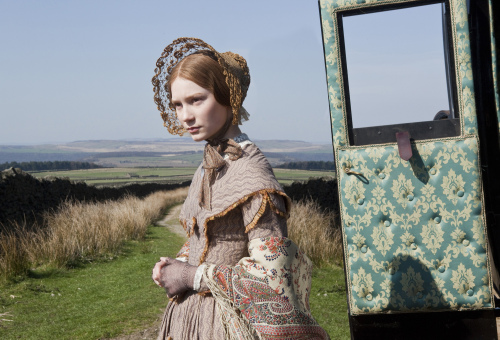“You can only breathe so much in corsets,” says Mia Wasikowska, who was required to wear such an apparatus, along with various bell-shaped skirts, flounced petticoats, and tight little bonnets, as she assayed the title role in the new and beautifully miserable “Jane Eyre.”
“It restricts your voice and your breath, and it’s really symbolic of the repression of the day,” she observes. “That’s very much what that time represented for women ― physical repression that becomes mental. Oh, it’s crazy.”
In this new iteration of the oft-filmed “Jane Eyre,” director Cary Fukunaga (“Sin Nombre”) and his costume designer drew their wardrobe inspiration from the fashions of the early 1840s. There’s one emotionally devastating scene in which Wasikowska’s Jane frantically tries to get out of her corset, with a close-up of her fingers on the laces as she desperately unknots row after row. She’s like a scuba diver in trouble, madly trying to untangle in the deep, struggling to shed the malfunctioning oxygen tank, and making for the surface.
“It’s the same thing with me when I get home at the end of the day,” Wasikowska says, laughing. “The first thing I do is I take everything off and jump into my pajamas.
”Freedom.“
For Wasikowska, playing Charlotte Bronte’s star-crossed heroine was a dream come true. When the Australian actress, all of 21 now, had finished Tim Burton’s ”Alice in Wonderland“ in 2009, she went back to her parents’ home in Canberra, waiting for news of potential projects.
“It was the first time I had been home and didn’t have any schoolwork to do,” she recalls, on the phone from New York recently, “so I was like, ‘Whoa, what am I going to do?’
“So I made a list of ‘the classics’ ― books that I thought I should get to ― and Jane Eyre was there on the bookshelf, so I started reading. I was at Chapter 5 and I called my agent up and asked if there was a script around, and there wasn’t at the time. The book was incredible, and so dense, just Jane’s internal monologue from start to finish. ... But two months later she called me and she said, ‘Here’s the script, and the director would like to meet with you.’”
The rest is history. Or, more accurately, Victorian Gothic feminist fiction.
Shot on the moors and dales of Derbyshire, where the skies are forever sheathed in clouds, and in historic country houses that Fukunaga and his crew lit solely by candlelight, “Jane Eyre” stars Michael Fessbender as the mercurial and brooding Rochester. The actor, who played Irish Republican Bobby Sands in the riveting “Hunger,” is only slightly less daunting and charismatic than Orson Welles was in the 1943 adaptation. Joan Fontaine, then 26, was the estranged, woebegone Jane in Robert Stevenson’s version.
“I definitely wanted to cast young, and I wanted to cast someone who wasn’t your standard Hollywood face,” says Fukunaga in a separate interview.
“I wanted someone who had an intelligent and emotionally subtle approach to acting,” he explains. “And I was introduced to Mia through friends who told me to see what she did in ‘In Treatment.’ And I was just floored by how much of a raw and natural talent she has.”
In the first season of HBO’s “In Treatment,” Wasikowska was Sophie, a teen gymnast with suicidal impulses who sought counsel from therapist Gabriel Byrne. It was a part, and a performance, that put the then unknown on the map.
“I feel really lucky to have played a character like Sophie,” Wasikowska says. “It’s really rare to find a character that conveys so truthfully what it’s like to be an adolescent in this time, and to be dealing with so many issues. And as a young actress ― I was 16, I think, or 17, then ― to get the chance to explore a character in that much depth. ... I just feel really lucky to have played her.”
 |
Mia Wasikowska stars as the title character of the romantic drama Jane Eyre directed by Cary Fukunaga. (Focus Features/MCT) |







![[Today’s K-pop] Blackpink’s Jennie, Lisa invited to Coachella as solo acts](http://res.heraldm.com/phpwas/restmb_idxmake.php?idx=644&simg=/content/image/2024/11/21/20241121050099_0.jpg)